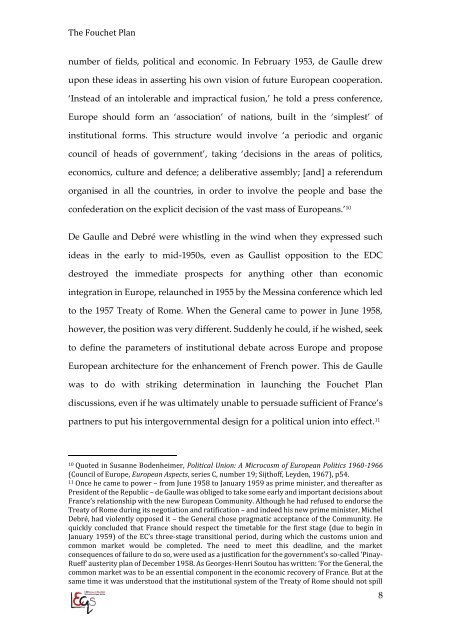The Fouchet Plan De Gaulle’s Intergovernmental Design for Europe
n?u=RePEc:eiq:eileqs:117&r=cdm
n?u=RePEc:eiq:eileqs:117&r=cdm
Create successful ePaper yourself
Turn your PDF publications into a flip-book with our unique Google optimized e-Paper software.
<strong>The</strong> <strong>Fouchet</strong> <strong>Plan</strong><br />
number of fields, political and economic. In February 1953, de Gaulle drew<br />
upon these ideas in asserting his own vision of future <strong>Europe</strong>an cooperation.<br />
‘Instead of an intolerable and impractical fusion,’ he told a press conference,<br />
<strong>Europe</strong> should <strong>for</strong>m an ‘association’ of nations, built in the ‘simplest’ of<br />
institutional <strong>for</strong>ms. This structure would involve ‘a periodic and organic<br />
council of heads of government’, taking ‘decisions in the areas of politics,<br />
economics, culture and defence; a deliberative assembly; [and] a referendum<br />
organised in all the countries, in order to involve the people and base the<br />
confederation on the explicit decision of the vast mass of <strong>Europe</strong>ans.’ 10<br />
<strong>De</strong> Gaulle and <strong>De</strong>bré were whistling in the wind when they expressed such<br />
ideas in the early to mid-1950s, even as Gaullist opposition to the EDC<br />
destroyed the immediate prospects <strong>for</strong> anything other than economic<br />
integration in <strong>Europe</strong>, relaunched in 1955 by the Messina conference which led<br />
to the 1957 Treaty of Rome. When the General came to power in June 1958,<br />
however, the position was very different. Suddenly he could, if he wished, seek<br />
to define the parameters of institutional debate across <strong>Europe</strong> and propose<br />
<strong>Europe</strong>an architecture <strong>for</strong> the enhancement of French power. This de Gaulle<br />
was to do with striking determination in launching the <strong>Fouchet</strong> <strong>Plan</strong><br />
discussions, even if he was ultimately unable to persuade sufficient of France’s<br />
partners to put his intergovernmental design <strong>for</strong> a political union into effect. 11<br />
10 Quoted in Susanne Bodenheimer, Political Union: A Microcosm of <strong>Europe</strong>an Politics 1960-1966<br />
(Council of <strong>Europe</strong>, <strong>Europe</strong>an Aspects, series C, number 19; Sijthoff, Leyden, 1967), p54.<br />
11 Once he came to power – from June 1958 to January 1959 as prime minister, and thereafter as<br />
President of the Republic – de Gaulle was obliged to take some early and important decisions about<br />
France’s relationship with the new <strong>Europe</strong>an Community. Although he had refused to endorse the<br />
Treaty of Rome during its negotiation and ratification – and indeed his new prime minister, Michel<br />
<strong>De</strong>bré, had violently opposed it – the General chose pragmatic acceptance of the Community. He<br />
quickly concluded that France should respect the timetable <strong>for</strong> the first stage (due to begin in<br />
January 1959) of the EC’s three-stage transitional period, during which the customs union and<br />
common market would be completed. <strong>The</strong> need to meet this deadline, and the market<br />
consequences of failure to do so, were used as a justification <strong>for</strong> the government’s so-called ‘Pinay-<br />
Rueff’ austerity plan of <strong>De</strong>cember 1958. As Georges-Henri Soutou has written: ‘For the General, the<br />
common market was to be an essential component in the economic recovery of France. But at the<br />
same time it was understood that the institutional system of the Treaty of Rome should not spill<br />
8


